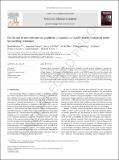| dc.contributor.author | Almousa, Nouf | |
| dc.contributor.author | Dacus, Benjamin | |
| dc.contributor.author | Woller, Kevin Benjamin | |
| dc.contributor.author | Shin, Ji Ho | |
| dc.contributor.author | Jang, Changheui | |
| dc.contributor.author | Shao, Lin | |
| dc.contributor.author | Garner, Frank A | |
| dc.contributor.author | Gabriel, Adam | |
| dc.contributor.author | Short, Michael P | |
| dc.date.accessioned | 2021-12-09T21:30:31Z | |
| dc.date.available | 2021-11-01T16:40:44Z | |
| dc.date.available | 2021-12-09T21:30:31Z | |
| dc.date.issued | 2021-03 | |
| dc.date.submitted | 2021-01 | |
| dc.identifier.issn | 1044-5803 | |
| dc.identifier.uri | https://hdl.handle.net/1721.1/136974.2 | |
| dc.description.abstract | Transient grating spectroscopy (TGS), a non-contact ultrasonic materials analysis technique, is proposed to rapidly and indirectly assess relative void swelling resistance of multiple structural materials. Statistically significant changes in the frequency of probed surface acoustic waves (SAWs) suggest that newly developed steels containing nanosized precipitates show higher resistance to void swelling when compared to their simpler, commercial analogues. The higher reduction in SAW frequency seen in the simpler steels, proportional to porosity, indicates more void formation which is directly validated by TEM examinations. This example illustrates the minimum set of targeted TGS studies required to quickly and inexpensively rank materials by relative void swelling resistance, and hence, accelerate materials development and characterization. | en_US |
| dc.language.iso | en | |
| dc.publisher | Elsevier BV | en_US |
| dc.relation.isversionof | http://dx.doi.org/10.1016/J.MATCHAR.2021.111017 | en_US |
| dc.rights | Creative Commons Attribution-NonCommercial-NoDerivs License | en_US |
| dc.rights.uri | http://creativecommons.org/licenses/by-nc-nd/4.0/ | en_US |
| dc.source | Prof. Short | en_US |
| dc.title | On the use of non-destructive, gigahertz ultrasonics to rapidly screen irradiated steels for swelling resistance | en_US |
| dc.type | Article | en_US |
| dc.identifier.citation | Almousa, Nouf et al. "On the use of non-destructive, gigahertz ultrasonics to rapidly screen irradiated steels for swelling resistance." Materials Characterization, 174 (April 2021): 111017. © 2021 Elsevier Inc. | en_US |
| dc.contributor.department | Massachusetts Institute of Technology. Department of Nuclear Science and Engineering | en_US |
| dc.relation.journal | Materials Characterization | en_US |
| dc.eprint.version | Author's final manuscript | en_US |
| dc.type.uri | http://purl.org/eprint/type/JournalArticle | en_US |
| eprint.status | http://purl.org/eprint/status/PeerReviewed | en_US |
| dc.date.updated | 2021-11-01T14:16:00Z | |
| dspace.orderedauthors | Almousa, N; Dacus, B; Woller, KB; Shin, JH; Jang, C; Shao, L; Garner, FA; Gabriel, A; Short, MP | en_US |
| dspace.date.submission | 2021-11-01T14:16:04Z | |
| mit.journal.volume | 174 | en_US |
| mit.license | PUBLISHER_CC | |
| mit.metadata.status | Complete | en_US |
